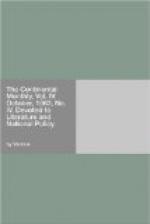were the poison that did the mischief. But the
reports have probably some foundation in truth.
An oppressed race, seldom daring to strike openly,
would be very apt to devise subtle ways of vengeance.
It will be remembered that one of the most frequent
items in our own Southern newspapers used to be accounts
of attempts made by slave girls to poison their masters’
families. Arsenic, which they commonly used,
is a clumsy means, almost sure to be detected; but
in the West Indies, where the proportion of native
Africans was always very large, the African sorcerers,
the dreaded Obi-men, who exercise so baleful a power
over the imaginations of the blacks, appear also to
have availed themselves of other than imaginary charms
to keep up their credit as the disposers of life and
death, and to have often gained such a knowledge of
slow vegetable poisons as made them formidable helpers
of revenge, whether against their own race or against
the race of their oppressors. In a recent Jamaica
story of Captain Mayne Reid’s, the plot centres
in the hideous figure of an old Obi-man, who wreaks
his revenge for former wrongs in this secret way,
destroying victim after victim from among the lords
of the soil. The piece is stocked with horrors
enough for the most ravenous devourer of yellow-covered
literature, but nevertheless it is so true to the
conditions of life in the old days of Jamaica, that
it is well worth reading for a lively sense of the
time when the fearful influences of savage heathenism,
slavery, and tropical passion were working together
in that land of rarest beauty and of foulest sin.
Evil enough remains, but, thank God, the hideous shadows
of the past have fled away forever.
But these tragical remembrances and suspicions belong
rather to the plains, into which we are about to descend.
Here we feel distinctly that we are in the tropics.
The sweltering heat, tempered, indeed, by the land
and sea breezes, but still sufficiently oppressive,
and almost the same day and night, leaves no doubt
of this fact. Vegetation, too, appears more distinctly
tropical. The character of the landscape in the
two regions is quite different. In the uplands
the wealth of glowing green swallows up peculiarities
of form, and presents little difference of color except
the endless diversity of its own shades. There
are, however, some distinct features of the landscape.
Conspicuous on every hillside are the groves ‘where
the mango apples grow,’ their mass of dense
rounded foliage looking not unlike our maples, and
giving a pleasant sense of home to the northern sojourner.
The feathery bamboo, most gigantic of grasses, runs
in plumy lines across the country. Around the
negro cottages, here and there, rise groups of the
cocoanut palms, giving, more than anything else, a
tropical character to the landscape. On a distant
eminence may perhaps be seen a lofty ceiba or cotton
tree, its white trunk rising sixty or seventy feet
from the ground without a limb, and then putting out




